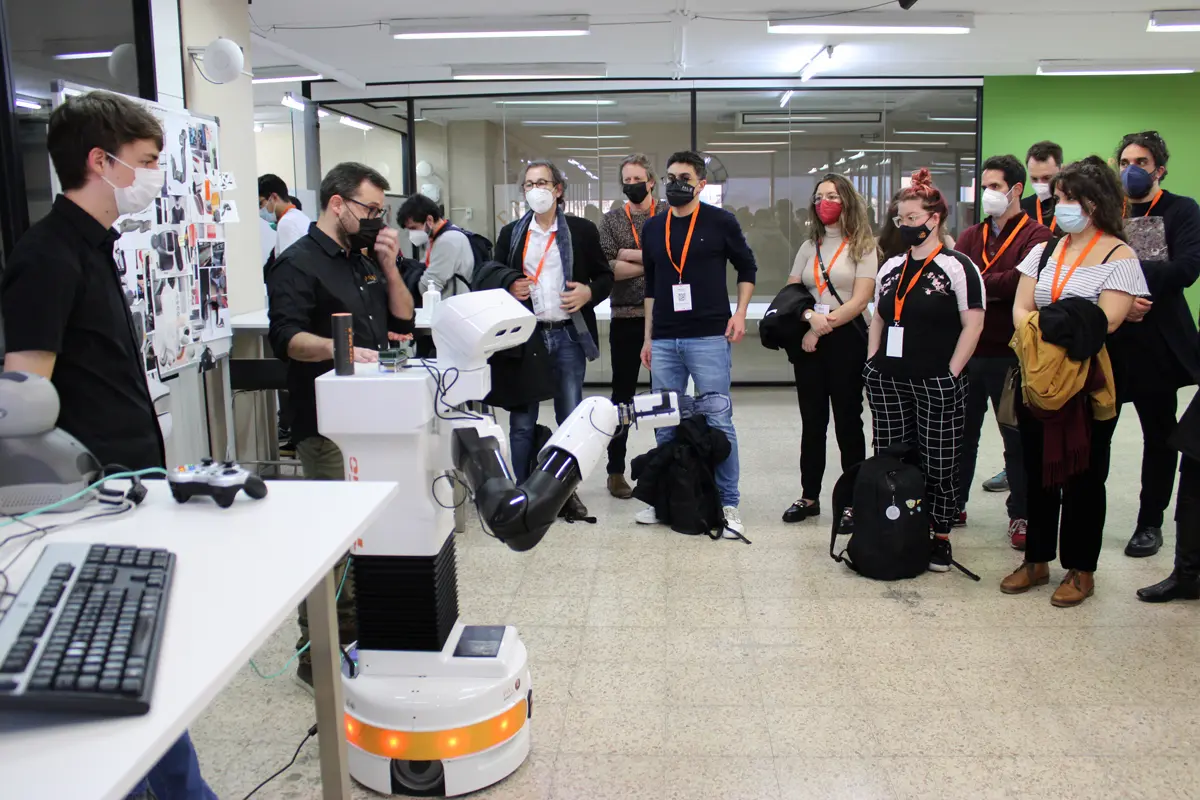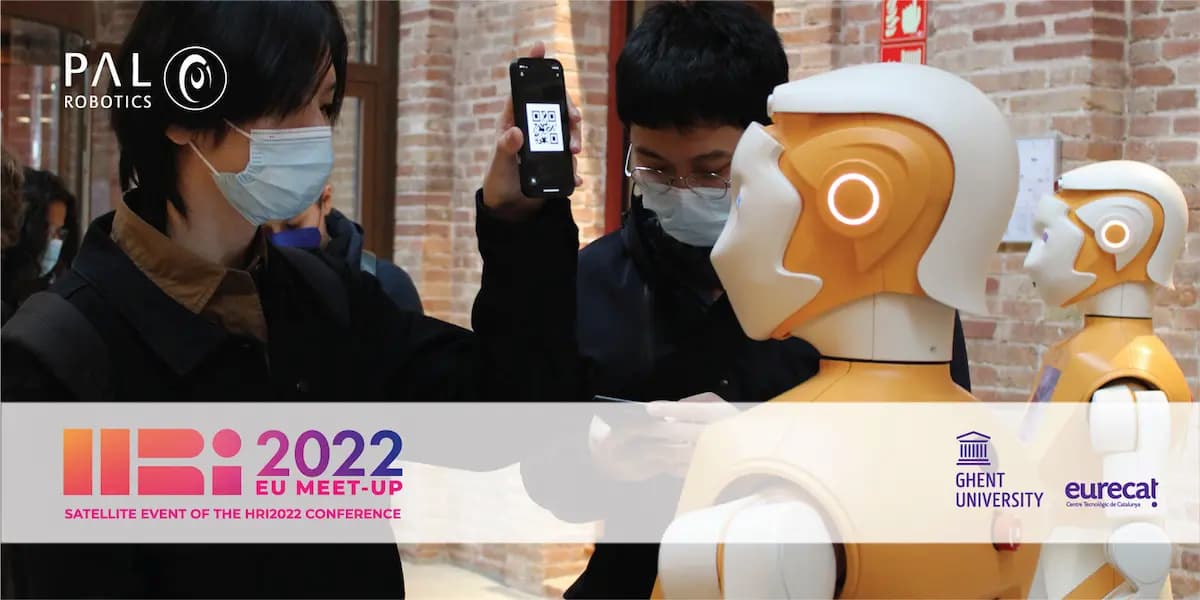The 2022 HRI Meeting
Last week, we had the opportunity to host the HRI meet-up in Barcelona together with Eurecat and co-organisers Ghent University. The event took place in Ca l’Alier, in Poblenou, Barcelona, where we gathered researchers for an in-person experience of the 17th Annual ACM/IEEE International Conference on Human-Robot Interaction (HRI 2022). This provided an opportunity for the community to meet physically in Barcelona and share their experiences, after not being able to meet in person for some time due to the COVID-19 pandemic. At the event the group was able to watch a selection of keynotes and presentations from the conference via video, present in-person their latest findings, network, and discuss their research projects.
The HRI Conference takes place every year, as a premium event for publishing and presenting top-quality HRI research. The 17th Annual HRI conference theme was “Breaking Boundaries” and the conference seeks contributions from a broad set of perspectives, including technical, design, behavioural, theoretical, methodological, and meteorological, that advance fundamental and applied knowledge and methods in Human-Robot Interaction.

PAL Robotics’ presentations including long-term social robot behaviour
The team at PAL Robotics had the opportunity to take part in a variety of talks and presentations at the HRI Conference:
- Workshop: Participatory Design and End-User Programming for Human-Robot Interaction
On the first day of the event, PAL robotics HRI Senior Scientist Dr. Séverin Lemaignan was invited as a speaker in this workshop on the Participatory Design and End-User Programming for Human-Robot Interaction. He presented the recent progress on interactive machine-learning to teach robots to become better social ‘helpers’.
- Late-Breaking reports by researchers Sara Cooper and Lorenzo Ferrini: Towards using Behaviour Trees for Long-term Social Robot Behaviour and Kinematically-Consistent Real-time 3D Human Body Estimation for Physical and Social HRI
PAL Robotics’ Robotics Software Engineer Sara Cooper, presented our latest research on the use of behaviour trees for long-term social robot behaviour.
PAL Robotics’ PhD student Lorenzo Ferrini also presented our recent results in integrating automatic detection of humans in the vicinity of our robots, including the automatic correction of detection inaccuracies by using a ‘template’ of the human’s body kinematics.
- Session: Understanding and Leveraging Humans/ Topic: Automatic Frustration Detection / Using Thermal Imaging
PAL Robotics’ Séverin Lemaignan co-presented a (full) paper during the main programme of the conference: “Automatic Frustration Detection Using Thermal Imaging” by Youssef Mohamed, Giulia Ballardini, Maria Teresa Parreira, Séverin Lemaignan, and Iolanda Leite.
- Workshop: TRAITS
This workshop was a continuation of a successful workshop at the HRI conference in 2021. This second edition, focussed on the AI algorithms required to implement autonomous and proactive interactions as well as AI techniques that can make the robot explain itself and its behaviour being legible and understandable by humans.
PAL Robotics’ Sara Cooper made a contribution presentation, where she talked about the ‘Lessons Learnt from Deploying ARI in Residential Care‘, in a session hosted by Antonio Andriella, Research Scientist in Social Robotics at PAL Robotics. In this presentation Sara Cooper told us about the development of robot ARI and the hands-on training at Clínica Humana last year, where we tested and gathered feedback. This work has been supported by SHAPES, one of the EU projects PAL Robotics is a partner in.
PAL Robotics’ commitment to the scientific community in Human-Robot Interaction
Beyond these scientific contributions, PAL Robotics is also actively engaging with the HRI research community through a range of actions.
PAL Robotics’ Séverin Lemaignan and Raquel Ros introduced and chaired a novel track at the HRI Conference, called ‘Short Contributions’, and aimed at promoting open and reproducible science. It facilitates the dissemination of technical know-how by offering HRI practitioners a new publication venue for replication studies, software and datasets.
Read more about Séverin Lemaignan’s interview on robots and social bonds and Raquel Ros’ interview on social robotics and relatability to society.
Séverin Lemaignan was also co-chairing the ‘Late Breaking Reports’, supporting the dissemination and presentation during the conference of 100+ on-going projects currently taking place within the HRI community. He is also a member of the HRI steering committee, and participated last week in the yearly HRI Steering Committee meeting, where mid-term and long-term strategy for the scientific community in HRI is discussed and shaped.

Interviews on the future of HRI including robots in the home
During the HRI meet-up event we took the opportunity to ask some of the group their thoughts on HRI and the future.
Regarding the most rewarding element of HRI, according to Barbara Bruno from EPFL,“when robots fail or when robots do something that is not predictable, then this makes the human react to that and it shows how adaptive we are, how intelligent we are and I think that is very rewarding to be in a field that reminds us constantly how nice it is to be a human.”
In terms of the future of HRI, Tony Belpaeme from Ghent University told us, “I hope that one day we‘ll have robots in the home, where this robot is almost a member of the family, that for me is the future.”
Finally, regarding what she is looking for in an HRI robot Barbara Bruno explained “First of all autonomy, together with that comes simplicity – what I want is a robot that shows it is a robot, shows it is not a human, behaves like a robot, and is able through its interaction with a human to bring some support, some assistance and some benefit to the human it is interacting with.”

PAL Robotics’ EU projects including the adaptation of Socially Assistive Robots
At the HRI meet-up PAL Robotics had the chance to disseminate the following EU projects that we are project partners in:
SHAPES: SHAPES aims to create an environment that supports the deployment of digital solutions, including ARI robot, to support healthy and independent living for older individuals. The goal of the project is to bring greater efficiency that increases health care and provision across Europe.
SPRING: The goal of SPRING is for ARI robot to be able to participate in different user-cases in a hospital environment. Therefore the project is focused on the adaptation of Socially Assistive Robots.
Open Dr: The main goal of the Open Dr project is in harnessing deep learning to provide advanced perception and cognition abilities in robotics. The aim is to be able to use these robotic applications in areas such as healthcare with TIAGo robot, agri-food, and agile production.
NhOA: The general objective of NHoA is the co-design of a socially intelligent assistive robot for the home that is robust, adaptable, and fosters user acceptance. PAL Robotics’ TIAGo robot takes part.
TALBOT: The aim of TALBOT is to develop a cognitive architecture for humanoid robots ARI and TIAGo supporting adaptability to be validated in healthcare applicative scenarios, and in particular in a day hospital for users of diverse ages.
Pro-cared: Pro-cared aims to develop a new enabling technology: personalisation, and will design and develop mechanisms for personal robots to proactively interact with children in education providing them with adaptive and personalised assistance. PAL Robotics’ robots ARI and TIAGo take part.
ARI robots at the event for Human-Robot Interaction: greeting and registering guests
ARI robot is PAL Robotics’ latest humanoid platform specifically designed for HRI and front-desk activities, and building on state-of-art Service Robotics and Artificial Intelligence.
At the HRI meet-up event, three ARI robots, each with a unique personality, were greeting and registering participants, through QR codes. The robots would ask the participants about their scientific expertise, and then suggest colleagues with similar interests. In addition to small games and providing general information about the event, the robots could also take souvenir photos, and email them directly to the participants.
The HRI EU meet-up was sponsored by PAL Robotics and Eurecat, which is the major Technological Centre of Catalonia and aims to contribute to the improvement of competitiveness of companies through the generation of technological knowledge, and co-organised by Ghent University, one of the major universities in Belgium.
Finally, we thoroughly enjoyed the opportunity to bring together experts from across Europe at the HRI meet-up, as well as the opportunity to take part in the Human-Robot Interaction 2022 Conference. We would like to thank everyone who participated as well as all event organisers and sponsors. We look forward to opportunities to meet again in the future!
To find out more about PAL Robotics and our work, visit our blog and to ask any questions don’t hesitate to contact us. If you’re searching for project or event partners don’t hesitate to get in touch – we are always looking for new opportunities to collaborate.
